Amaryllis, the care of which is quite simple, if you follow the simple rules, is a bulbous plant from the same family. A native of South Africa was introduced into Europe in the XVIII century, where he quickly took one of the leading positions among the flowering decorative cultures.
Material Content:
Types and varieties of plants
The genus is represented by the only species that is known under two names - Amaryllis Belladonna or Amaryllis the Beautiful. A perennial plant with a bulbous root system has xiphoid basal leaves in two rows, framing a fleshy peduncle up to 60 cm tall. When flowering, an umbrella inflorescence is formed at the end of the arrow, consisting of flowers with a diameter of 5-8 cm with a variety of colors, depending on the variety.

After the appearance of amaryllis in the gardens and on the windowsills of Europeans, breeders do not stop working on breeding new varieties, among which stand out:
- Durban - a large-flowered variety, distinguished by carmine-red bell-shaped flowers with a white throat.
- Parker - A typical representative of the pink color with a yellow base of petals.
- Ice queen - A variety with large flowers, consisting of glossy white petals with creamy coating on the edges.
- Vera - pink flowers of this variety have a distinctive feature in the form of pearly plaque.
- Red lion - A beautiful representative of the species with large flowers, painted intensely red.
- La paz - An original variety with flowers consisting of narrowed green petals with a fringing in the form of a red spraying.
Amaryllis: cultivation features
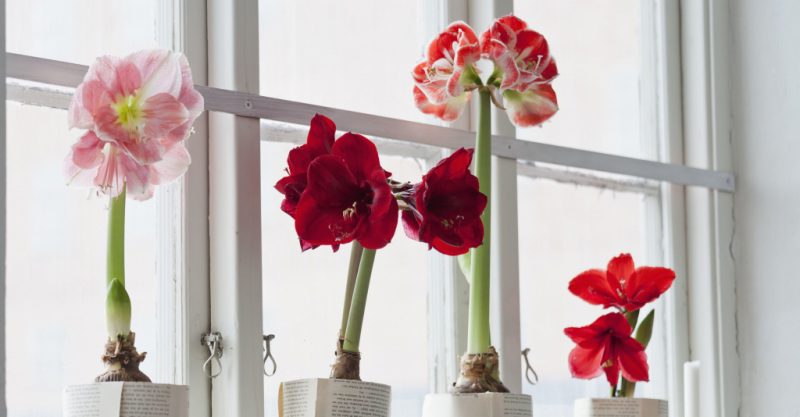
The plant, which is highly decorative in combination with undemanding, has a number of features associated with the natural growth environment that must be considered when cultivating a flower at home:
- a sufficient amount of light;
- moderate watering;
- proper pot selection;
- regular feeding.
Home Care
Successful cultivation of amaryllis involves compliance with basic care measures.
Lighting and location
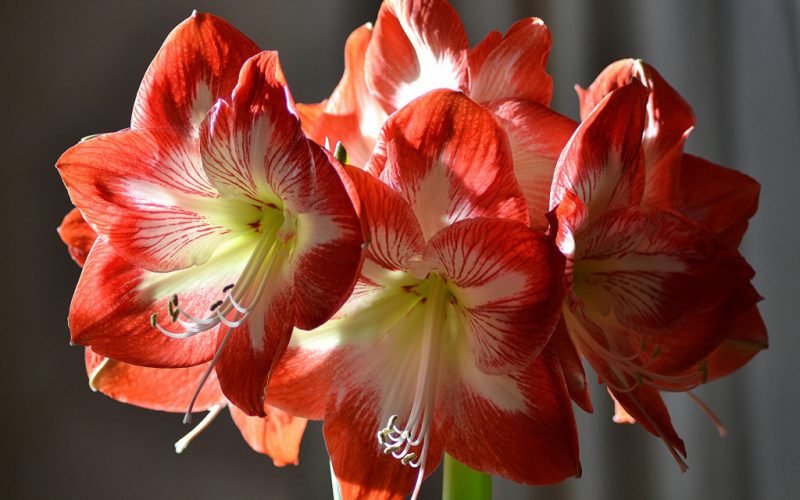
Amaryllis needs a stream of soft light, which can provide a flower when placing the pot on the windowsills of the southeast and southwest directions with additional protection from direct sunlight during the period of greatest solar activity. As protection, curtains can be used.
Important! In the summer season, daylight hours must be at least 16 hours.
Temperature

The temperature regime for the full development of amaryllis depends on the development phase:
- In the phase of active growth, the optimum temperature varies from 18 to 25 ° C depending on the time of day.
- During the rest period, the temperature regime in the range from 10 to 16 ° C is ensured.
Caution! When cultivating a culture, one must not allow strong temperature differences that negatively affect the plant.
Soil and pot requirement
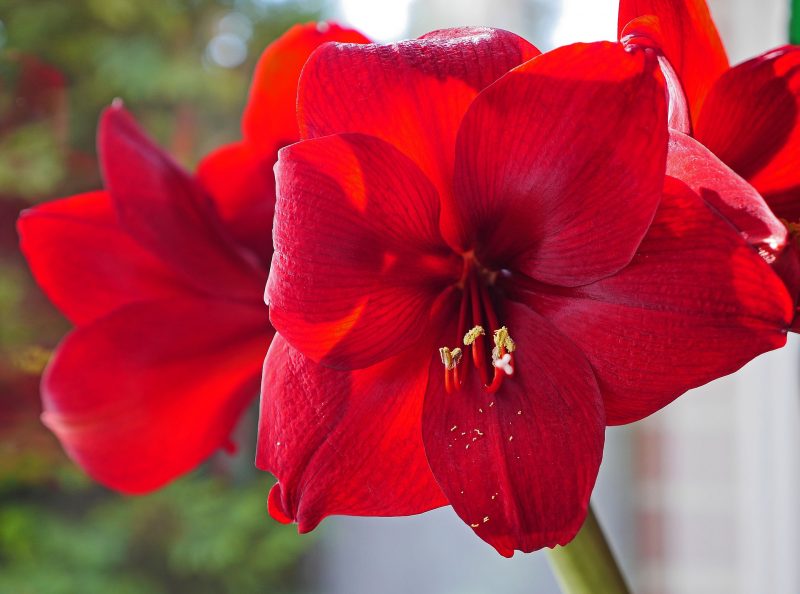
To obtain a flowering plant, it is necessary to select a small capacity. Soil for filling the pot is required with a slightly acid reaction in the range of 6.0-6.5 points and a loose structure. The nutrient substrate, prepared from turf and leafy soil, sand and humus in a ratio of 2: 2: 2: 1, is calcined before use in an oven to destroy pathogens.
Watering a flower and humidity
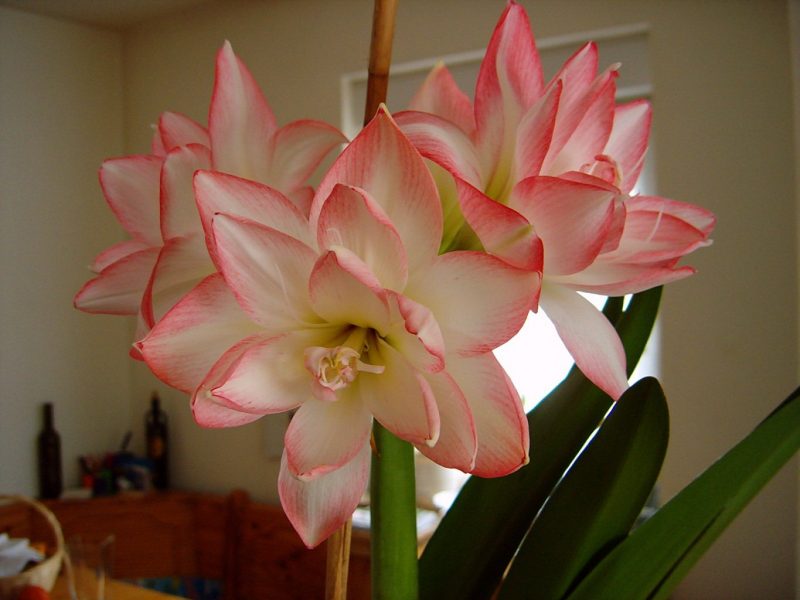
When watering the flower, which should be carried out after drying of the earthen coma, the lower method of moistening is used: the pot is placed in a tray with water for 20-30 minutes, which helps to prevent unwanted water from entering the bulb, which occurs with the upper method of irrigation. Amaryllis easily adapts to the dry air in the apartment, so it does not require additional spraying.
Advice! To facilitate the breathing of the flower through the leaf plates, you should systematically wipe them from dust.
Fertilizer and fertilizer
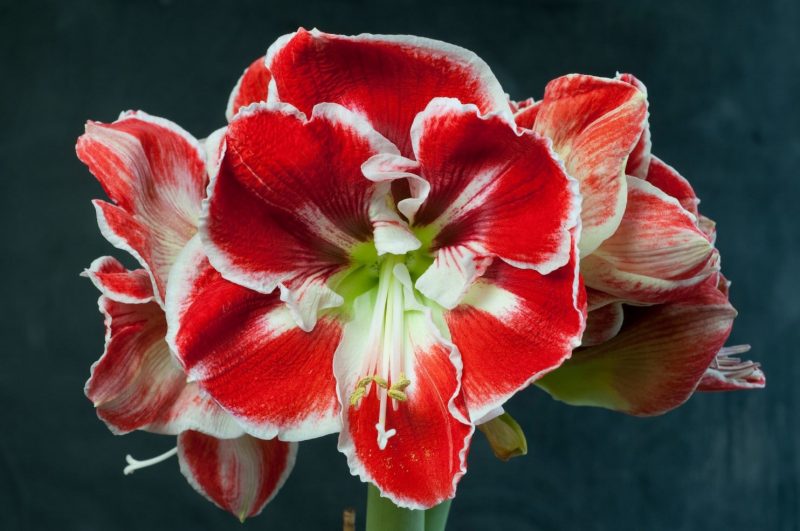
Amaryllis needs regular feeding during a period of active growth:
- bird droppings diluted in water in a proportion of 10 g per bucket of liquid;
- mullein at the rate of 250 g per bucket of water;
- a solution of mineral fertilizers with a slight nitrogen content prepared from a bucket of water and 3 g of agrochemical
Attention! An excess of nitrogen in the soil can cause a red burn of the flower.
Flowering and pruning
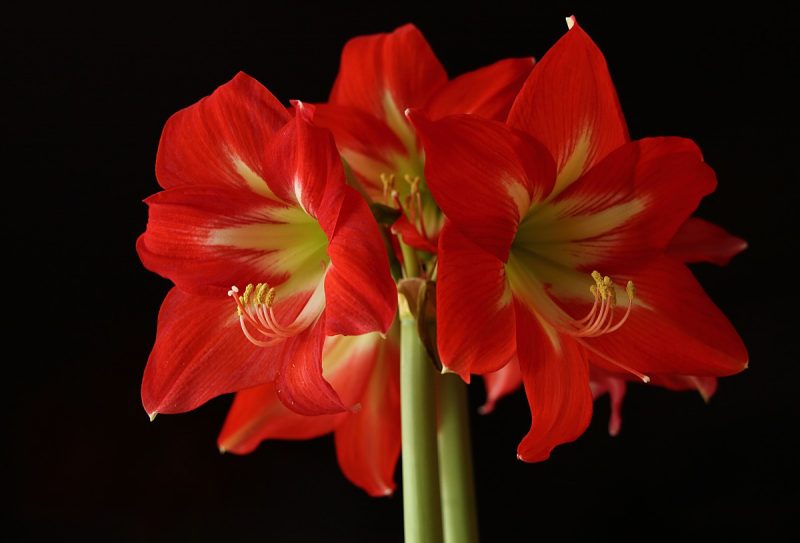
With the advent of autumn, a flowering culture is observed, which occurs in contrast to hippeastrum after the development of green mass. In the natural environment, this period, during which white and pink flowers bloom, falls in the fall. In the culture of many varieties with a variety of colors. After flowering, the shoots die off naturally, and pruning is not required.
Transfer
Amaryllis flower is transplanted every 3-4 years after flowering is completed.
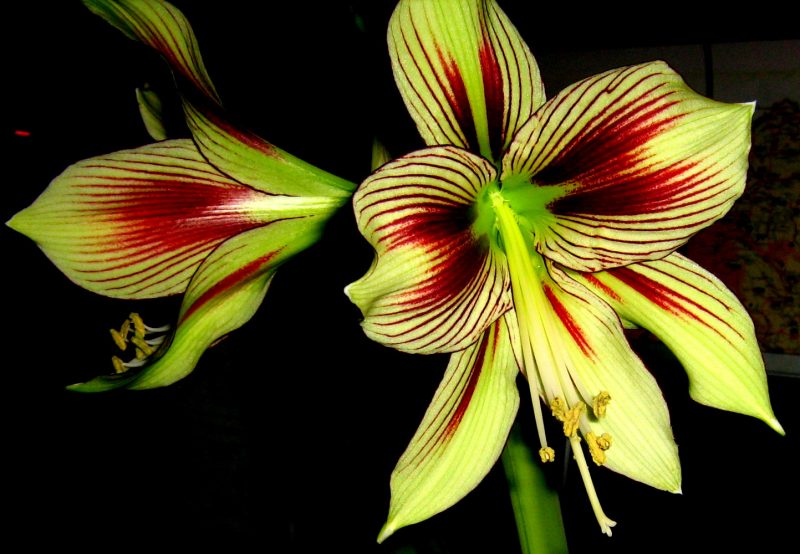
The procedure is as follows:
- A new container is selected so that the distance between the wall of the pot and the edge of the bulb is 2-3 cm.
- Expanded clay drainage is placed at the bottom of the pot.
- The bulb is examined for the presence of diseases and placed in a pot, after which it is sprinkled with a new substrate so that ⅓ part remains above ground level.
- The substrate is compacted and slightly moistened.
Rest period
After the completion of the flowering phase, the plant begins to prepare for a dormant period, which lasts 2 months on average: watering and feeding are reduced. The discharge of foliage signals the beginning of the active growth of the bulb. At this time, the pot moves to a dark room where the temperature should not exceed 16 ° C. Moisturization is carried out as necessary when the earthen lump dries.
Pest and Disease Control
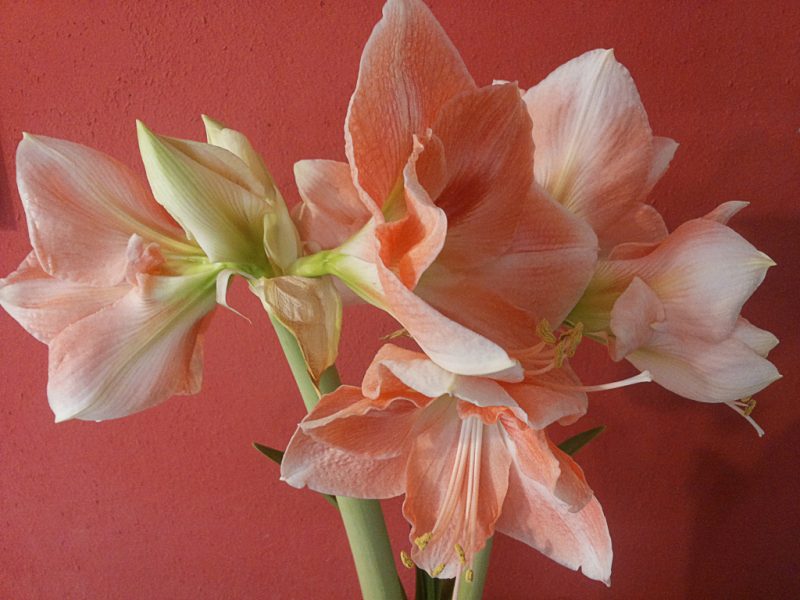
The flower is affected by diseases in the form of rot in violation of the maintenance regulations - excessive irrigation, high concentration of nitrogen-containing fertilizers in the substrate. With the intensive development of the disease, the plant may die. In order to prevent this, it is necessary to strictly observe agrotechnical requirements. Among the pests observed on amaryllis, spider mites, mealybugs and scale insects are distinguished, which should be controlled by spraying the plant with insecticidal preparations according to the instructions on the packaging.
Amaryllis reproduction
Amaryllis is bred in two ways: generative and vegetative.
Seeds
Due to the complexity of the method and the inability to maintain varietal qualities, seed propagation at home is extremely rare.

If nevertheless the flower grower has decided, then:
- An artificial pollination is carried out with a brush.
- Two months later, when the seed boxes begin to crack, seed is collected.
- Dried seeds are distributed on the surface of light moist soil in January-February, and sprinkled with a layer of earth of 0.5 cm.
- The container is kept at a temperature of 22-25 ° C under the glass until emergence.
- After the seedlings form 1 pair of real leaves, the seedlings are planted in separate pots.
Attention! New plants obtained in this way will please the first flowering only after a seven-year growth period.
Kids
At the next transplant, reproduction can be carried out by separating the children:
- With a sharp instrument, a baby with roots is separated from the mother’s bulb.
- Sections are disinfected with an antiseptic in the form of crushed activated carbon or a fungicide solution.
- A small onion is planted in a separate pot with a prepared substrate for amaryllis and moved to a warm room for rooting. After 1-3 years, mature bulbs capable of blooming will grow.
Bulb Division
The most popular technique in which:
- A large onion is selected, freed from the scales, and then divided into 4 parts.
- Delenka is immersed in a fungicide solution for disinfection.
- After half an hour, the parts are buried by ⅓ in a special substrate and kept at a temperature of 22 ° C until rooting.
Why amaryllis does not bloom, flowers and leaves turn pale?
Despite the unpretentiousness of the culture, non-compliance with the basic agrotechnical requirements can lead to a loss of decorative flower or a complete absence of inflorescences.
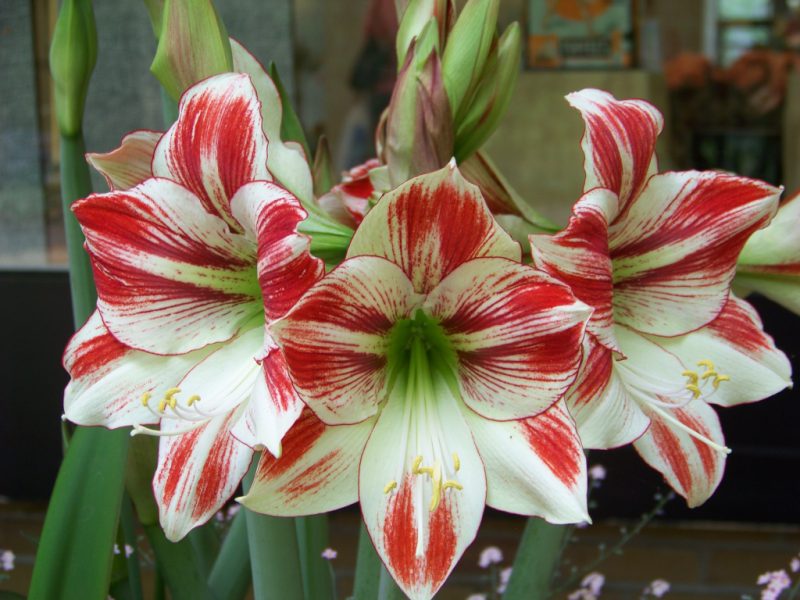
The main reasons are:
- lack of lighting;
- lack of macro and micronutrients;
- lack of a phase of rest;
- untimely transplantation;
- deep bulb closure;
- constant overflows leading to the development of diseases;
- incorrectly selected pot;
- the presence of pests.
Important! If less than three years have passed after planting the bulb, the absence of a flowering phase is a normal physiological process.
How to distinguish amaryllis from hippeastrum?
Often, hippeastrum from the tropical zones of South America, the genus of which has more than 85 species, is mistaken for amaryllis, represented by only one species.
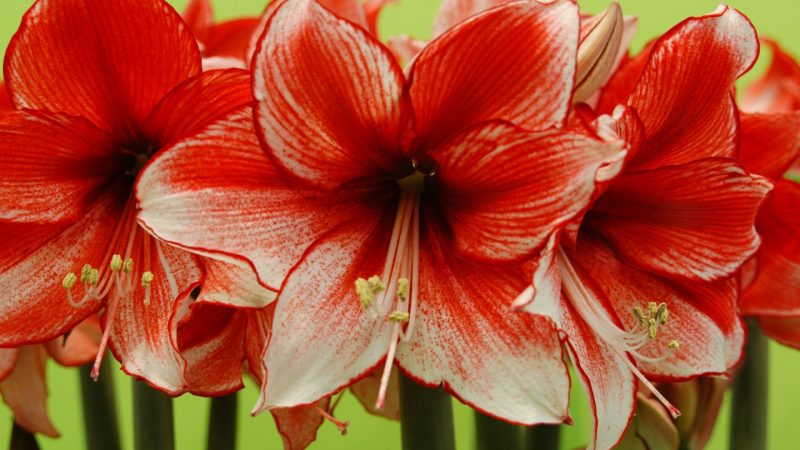
There are a number of parameters that will help the grower not to make a mistake:
- bulb - in amaryllis, the bulb has a pear-shaped shape, while in a tropical flower - rounded;
- inflorescence - in amaryllis umbrellas consist of 6-12 flowers, while in hippeastrum - of 6 pieces maximum;
- flowering - in amaryllis, flowers bloom in autumn, and in hippeastrum - in the spring and summer;
- flower stalk - at a hippeastrum a hollow arrow.
So, the amaryllis flower represents a failure of a beautifully flowering plant that requires minimal but proper care. Fulfillment of all requirements for maintaining the culture at home will allow the grower to get a healthy plant with beautiful large inflorescences of wondrous beauty.












